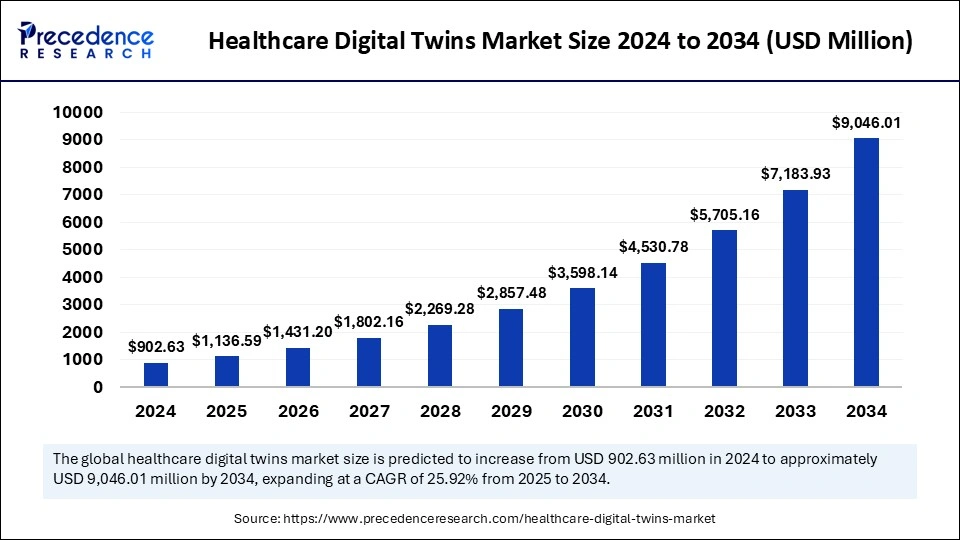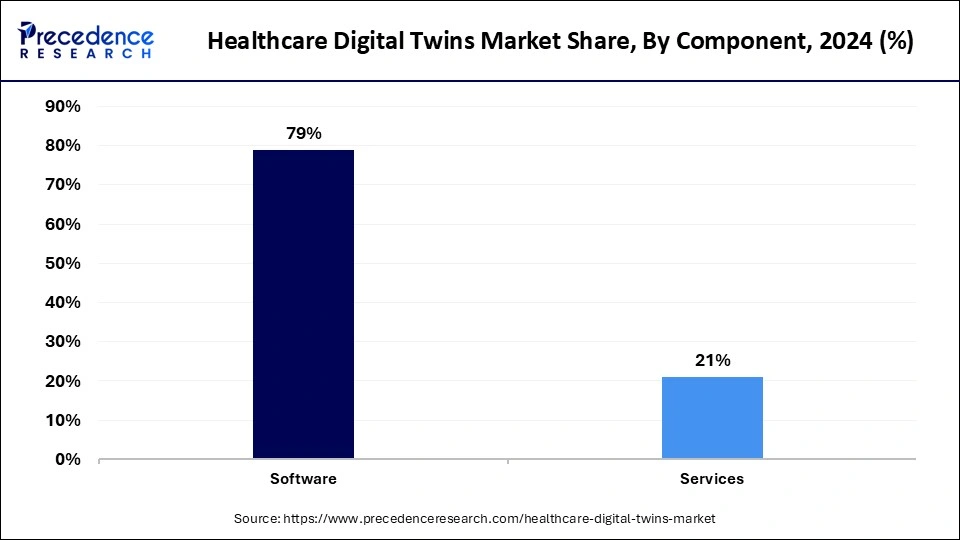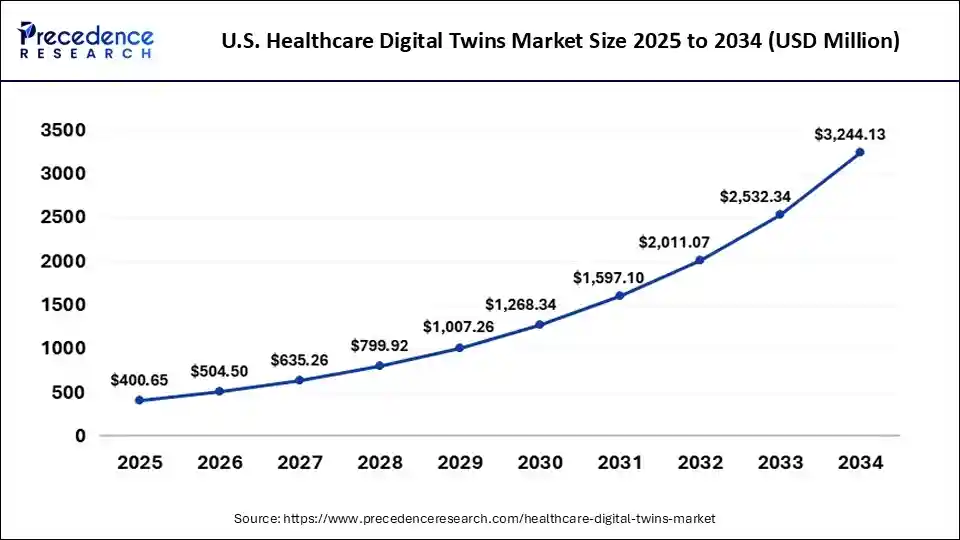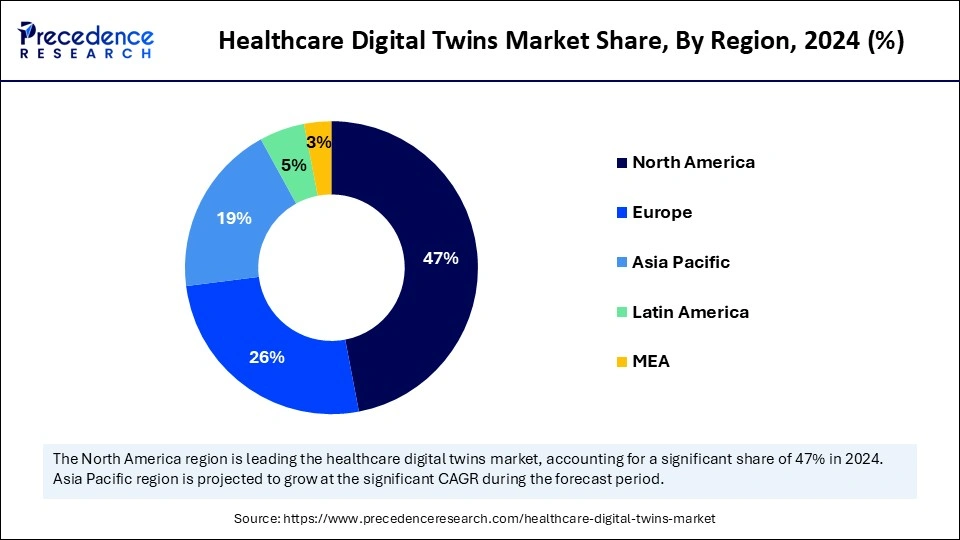What is the Healthcare Digital Twins Market Size?
The global healthcare digital twins market size is calculated at USD 1,136.59 million in 2025 and is predicted to increase from USD 1,431.20 million in 2026 to approximately USD 9,046.01 million by 2034, expanding at a CAGR of 25.92% from 2025 to 2034. The increasing adoption of this technology in the healthcare sector is the key factor driving market growth. Also, advancements in data analytics coupled with the increasing demand for personalized medicine can fuel market growth further.

Healthcare Digital Twins Market Key Takeaways
- North America dominated the global market with the largest market share of 46% in 2024.
- Asia Pacific is expected to grow at the fastest CAGR during the studied period.
- By component, the software segment contributed the highest market share of 79% in 2024.
- By application, the personalized medicine segment captured the biggest market share of 25% in 2024.
- By application, the medical device design and testing segment is expected to grow at the fastest CAGR over the forecast period.
- By end use, the provider's segment generated a major market share of 37% in 2024.
- By end use, the pharma and biopharma segment is projected to grow at a solid CAGR during the forecast period.
What is the Role of Artificial Intelligence (AI) in the Healthcare Digital Twin Market?
Artificial Intelligence-powered services in the healthcare digital twins market provide a broad view of a patient's health by combining data from many sources, such as wearable devices, electronic health records, and genetic information. Furthermore, AI-powered digital twinning helps optimize patients' responses to treatments and streamline personalized care plans. Hence, medical professionals can monitor and adjust treatment plans to get the desired outcomes.
- In December 2024, Rajiv Gandhi International Airport in Hyderabad became the first airport in India to get an AI-powered digital twin platform with the next-generation Airport Predictive Operation Centre (APOC). GMR Airports, which manages the Hyderabad Airport, said it launched the AI-enabled digital twin platform with the aim of revolutionizing airport operations.
Market Overview
A digital twin is a concept that blends many technological innovations to produce a virtual counterpart of a material system or object. It is generally applied to healthcare. The healthcare digital twins market has many applications in the healthcare domain, including boosting clinical trials, fuelling treatment efficiency, and overall cost savings in drug testing and design. This technology is reshaping many industries, effectively improving issue detection and efficiency for companies.
What are the Growth Factors in the Healthcare Digital Twins Market?
- Digital twins enhance patient care with predictive maintenance, which can soon boost healthcare digital twins' market growth.
- The increasing demand for digital twin repositories (DT banks) is expected to propel market growth shortly.
- Increasing operational efficiency and patient outcomes will likely propel the healthcare digital twins market growth further.
Healthcare Digital Twins Market Outlook
- Industry Growth Overview: From 2025 to 2030, the market will experience considerable and rapid growth due to the rise in predictive modeling uptake, patient-specific treatment planning, and hospital process optimization. Growth is further bolstered through rising digital health investment levels, especially in Asia-Pacific and North America.
- Sustainability Trends: Sustainability affects development regarding energy-efficient simulation platforms, reducing clinical trial waste, and optimizing resource allocation. Vendors are focusing on low-carbon approaches to computing and cloud-based architectures to meet stringent global healthcare sustainability targets.
- Global Expansion: Leading companies are expanding into Southeast Asia, the Middle East, and LATAM to support healthcare digitization programs. Companies are creating regional R&D hubs and establishing cloud partnerships to increase deployment speed and ensure compliance with domestic health regulations.
- Major Investors: Due to the high return on investment (ROI), considerable stickiness of software, and perfect synergy with the transformation of healthcare into an AI-centric world, private equity and strategic investors are ramping up, as firms like Bain Capital, TPG Capital, and General Atlantic are investing in platforms centered around innovative precision care modeling.
- Startup Ecosystem: The startup ecosystem is likewise strengthening, with innovators in physiological modeling, AI-based diagnostics, and virtual hospital twins beginning to take off. Firms like Unlearn.AI and Twin Health are attracting substantial VC rounds by generating large, scalable digital twin applications for chronic care and clinical trials.
Market Scope
| Report Coverage | Details |
| Market Size by 2034 | USD 9,046.01 Million |
| Market Size in 2025 | USD 1,136.59 Million |
| Market Size in 2026 | USD 1,431.20 Million |
| Market Growth Rate from 2025 to 2034 | CAGR of 25.92% |
| Dominating Region | North America |
| Fastest Growing Region | Asia Pacific |
| Base Year | 2024 |
| Forecast Period | 2025 to 2034 |
| Segments Covered | Component, Application, End Use, and Regions. |
| Regions Covered | North America, Europe, Asia-Pacific, Latin America, and Middle East & Africa. |
Market Dynamics
Drivers
Increasing adoption of telemedicine services
Many innovative technologies, such as digital tools, electronic medical records, telemedicine, streaming media, and store-and-forward imaging, have changed the healthcare digital twins market drastically. Furthermore, this technology is effectively used in remote patient monitoring and telemedicine to create a virtual representation of a patient's health history, offering a precise image of the patient's health.
- In 2023, Philips, one of the leading healthcare technology companies, took a significant step in this direction by developing a customized DT model based on unique computed tomography (CT) heart images.This personalized model contributes to a more precise diagnosis and facilitates surgical planning.
Restraint
The complexity of healthcare data sources
Data integration remains a major hurdle in the extensive adoption of digital twins in healthcare due to the heterogeneity of data sources. Also, the precision and reliability of digital twin models rely on algorithmic refinement and data updates. Moreover, significant investments in the training of healthcare professionals and technology infrastructure are required for effective digital twin implementation.
Opportunity
Digital Twins in precision and personalized medicine
The application of healthcare digital twins market technology in the medical sector holds massive potential. Research has demonstrated extensive use of digital twin technology in many medical domains, such as creating virtual twins that can simulate individual responses to various treatment options to model complicated diseases such as multiple sclerosis. Furthermore, their utility expands to streamline treatment plans, improving patient care.
- In January 2023, a strategic partnership between Microsoft, Schneider Electric, and Emirates Health Services led to the development of EcoStruxure for Healthcare. This innovative digital twin platform is designed to significantly enhance the efficiency and sustainability of UAE hospitals.
Component Insights
The software segment dominated the healthcare digital twins market in 2024 and is expected to grow at the fastest rate over the forecast period. The dominance and growth of the segment can be attributed to the surge in platform launches and approvals, which are boosting market growth. Additionally, medical professionals are increasingly utilizing simulation software to predict outcomes and model disease stages. This makes the software an essential component of precision medicine.

- In September 2024, the Smart City Living Lab announced the launch of its innovative Digital Twin for water utility network. This project was initiated five months ago in collaboration with ZF Technologies, a CSR initiative, and represents a significant advancement in smart city infrastructure management.
Application Insights
The personalized medicine segment dominated the global healthcare digital twins market in 2024. The dominance of the segment can be credited to the rising focus on R&D for individualized medicine along with the growing shift towards precision medicine. Digital twin technology enables the production of dynamic and detailed models of individuals' biological systems. Also, healthcare providers are using digital models to predict disease progression and detect potential risks.
The medical device design and testing segment is projected to grow at the fastest rate during the forecast period. This growth is associated with advancements in digital twin technology, which facilitate the modeling of medical devices and real-time simulations that promote segment growth. Additionally, these digital twins enable manufacturers to design devices customized to a patient's health condition, anatomy, and treatment plan needs.
- In May 2024, -Ontrak Inc., a leading AI-powered and technology-enabled healthcare company, announced the launch of its pioneering Mental Health Digital Twin (MHDT) technology. This innovative advancement in mental health care delivery seamlessly fuses human empathy with data-driven insights to provide personalized treatments.
End Use Insights
In 2024, the provider's segment led the healthcare digital twins market by holding the largest share. The dominance of the segment can be driven by the rising adoption of strategic initiatives by key players to boost the development of the healthcare industry. Digital twins are utilized in medical facilities to identify bed shortages and streamline hospital staff. In addition, this reduces costs and increases resource utilization.
The pharma and biopharma segment is projected to grow at the fastest rate over the forecast period. The growth of the segment can be credited to the rising need for cost-effective and faster drug development coupled with the increasing emphasis on personalized medicine. Furthermore, digital twins can be utilized to optimize patient responses to simulate dosage levels and treatments.
Regional Insights
U.S. Healthcare Digital Twins Market Size and Growth 2025 to 2034
The U.S. healthcare digital twins market size is exhibited at USD 400.65 million in 2025 and is projected to be worth around USD 3,244.13 million by 2034, growing at a CAGR of 26.14% from 2025 to 2034.

North America dominated the healthcare digital twins market in 2024. The dominance of the segment can be attributed to the strong presence of digital infrastructure and ongoing government initiatives. The region also boasts the presence of major market players such as IBM Corporation, Microsoft, and IQVIA. In North America, the U.S. led the market owing to the combination of innovative technological infrastructure and significant investment in R&D.
- In June 2023, Unlearn and QurAlis Corporation joined forces to utilize Unlearn's artificial intelligence digital twins in the clinical trials of QurAlis for amyotrophic lateral sclerosis therapies.
North America: Canada Healthcare Digital Twins Market Trends
Canada's market is gaining momentum as hospitals and research institutions increasingly leverage virtual patient models for personalized medicine and real-time monitoring. Integration of AI, cloud computing, and IoT is driving adoption, enabling predictive simulations of disease progression and treatment responses. Provincial health systems are partnering with tech firms to build enterprise-wide digital twins that process both structured data and clinical notes, which boosts care planning and early intervention.

Asia Pacific is expected to grow at the fastest rate in the healthcare digital twins market during the studied period. The growth of the region can be credited to the increasing investments by private investors, venture capitalists, and non-profit organizations in AI technology. Furthermore, the region is also experiencing growth in Internet of Things (IoT)devices that are increasingly utilized in healthcare applications.
Asia Pacific: India Healthcare Digital Twins Market Trends
India's market is growing rapidly as hospitals and pharmaceutical companies increasingly deploy virtual patient models to optimize personalized treatment and simulation-based care. Integration of AI and IoT technologies enables real-time monitoring and predictive analytics for chronic diseases, fostering proactive interventions. Investments by the government and public-private partnerships are fueling infrastructure development and regulatory support for digital twin adoption in healthcare settings.
Why did Europe Grow Significantly in the Healthcare Digital Twins Market?
In Europe, significant growth was recorded, as the area has established strong healthcare regulations, advanced hospital systems, and major investments in digital transformation. Countries have identified the use of AI tools as both an advancement in patient safety and a mechanism to reduce medical error. Europe also invested heavily in models that improve personalized care, allowing the use of digital twins to be feasible with treatment planning.
Germany Healthcare Digital Twins Market Trends
Germany was the leader in Europe with its strong medical technology sector and strong hospital infrastructure. Significant investment in AI and digitalization drove German hospitals to adopt more predictive tools. Many universities in Germany contributed research support to improve digital twin models in treatment planning. Strict quality standards created demand for systems to improve patient outcomes. Further enriched by strong government programs and partnerships between technology firms and hospitals, Germany sustained itself as the single leading market in Europe.
Why did Latin America Grow Significantly in the Healthcare Digital Twins Market?
Latin America experienced growth at a rapid pace, driven by increased investment by private companies in smart healthcare and growing recognition of the importance of digital transformation. In response to a region-wide push for lowering costs and increasing efficiency in hospitals, digital twins became relevant again. Collaborations with global tech firms aided early adoption of digital tools and healthcare systems expressed potential in the areas of emergency planning, patient monitoring, and managing hospital workflows.
Brazil Healthcare Digital Twins Market Trends
Brazil has led the region since it has invested in digital healthcare and tapped global tech companies to implement modern hospital solutions. Larger hospitals in major cities were testing systems to predict risk and plan for treatment. Government programs supporting digital systems prompted adoption as well. Brazil's private health sector was listed as an emerging opportunity in order to yield better patient care with the use of digital tools. In addition, the increasing prevalence of chronic diseases prompted hospitals to pursue digital twins more actively.
Why did the Middle East & Africa Grow Significantly in the Healthcare Digital Twins Market?
The Middle East & Africa experienced strong growth, driven by increased investment in smart hospitals, adoption of digital health technology, and government prioritization of advanced medical technologies. The Gulf countries with wealth facilitate automation and AI-based patient services and experience. Africa began the adoption of digital tools to manage the growing burden of health within the country. The region was a significant opportunity for hospital planning and capacity models, as well as remote care and digital health monitoring in a variety of settings.
The UAE Healthcare Digital Twins Market Trends
The UAE led the region with rapid investment in smart hospitals and digital transformation programs. The government actively supported the adoption of AI across health delivery services, including encouraging hospitals to test digital twin systems. There were many opportunities for partnerships to speed up AI developments and deployment. The UAE aimed to become a hub for medical innovation, which resulted in funding digital tools for each provider on behalf of the government.
Healthcare Digital Twins Market Companies

- Atos
- Microsoft
- Philips Healthcare
- PrediSurge
- Unlearn AI
- QiO Technologies
- Verto Healthcare
- Dassault Systems (3DS System)
- ThoughWire
- Faststream Technologies
- Twin Health
Latest Announcement by Market Leaders
- In October 2024, Microsoft announced a new collaboration with Be My Eyes to bring high-quality, disability-representative data to help train AI systems. This work with Be My Eyes will help make Microsoft AI models more inclusive for the 340 million people in the world who are blind or have low vision and is the latest step in our commitment to building inclusive technology.
- In November 2024, Royal Philips, a global leader in health technology, announced the expansion of its strategic collaboration with Amazon Web Services (AWS) to offer Philips' integrated diagnostics portfolio in the cloud, including radiology, digital pathology, cardiology, and AI advanced visualization solutions.
Recent Developments
- In February 2024, the AI firm Unlearn obtained USD 50 million in a Series C funding round led by Altimeter Capital to enhance clinical research through digital twin technology. The company planned to utilize the funding to further its goal of employing AI to minimize trial and error in healthcare.
- In March 2023, Unlearn.AI, Inc., which launched a platform that creates 'digital twin' profiles of patients in clinical trials, raised around USD 15 million in funding for expanding partnerships and accelerating regulatory approval. The company is working on AI (artificial intelligence) applications to build up digital twins to speed up clinical drug trials through neural networks.
Segments Covered in the Report
By Component
- Software
- Services
By Application
- Personalized Medicine
- Healthcare Workflow Optimization and Asset Management
- Medical Device Design and Testing
- Drug Discovery and Development
- Surgical Planning and Medical Education
- Others
By End Use
- Providers
- Pharma and Bio Pharma Companies
- Medical Device Companies
- Research and Academia
- Others
By Geography
- North America
- Asia Pacific
- Europe
- Latin America
- Middle East and Africa
For inquiries regarding discounts, bulk purchases, or customization requests, please contact us at sales@precedenceresearch.com
Frequently Asked Questions
Ask For Sample
No cookie-cutter, only authentic analysis – take the 1st step to become a Precedence Research client
 sales@precedenceresearch.com
sales@precedenceresearch.com
 +1 804-441-9344
+1 804-441-9344